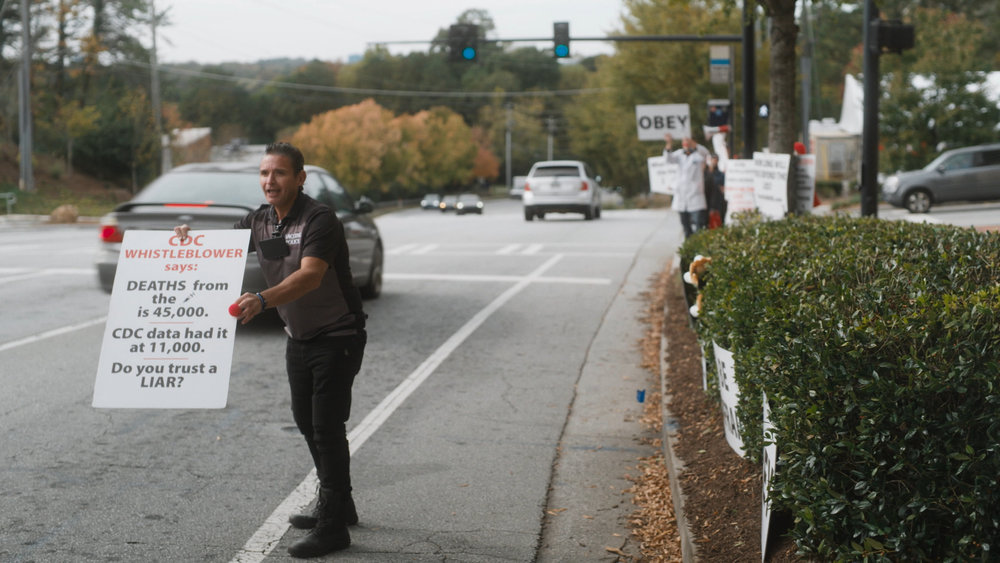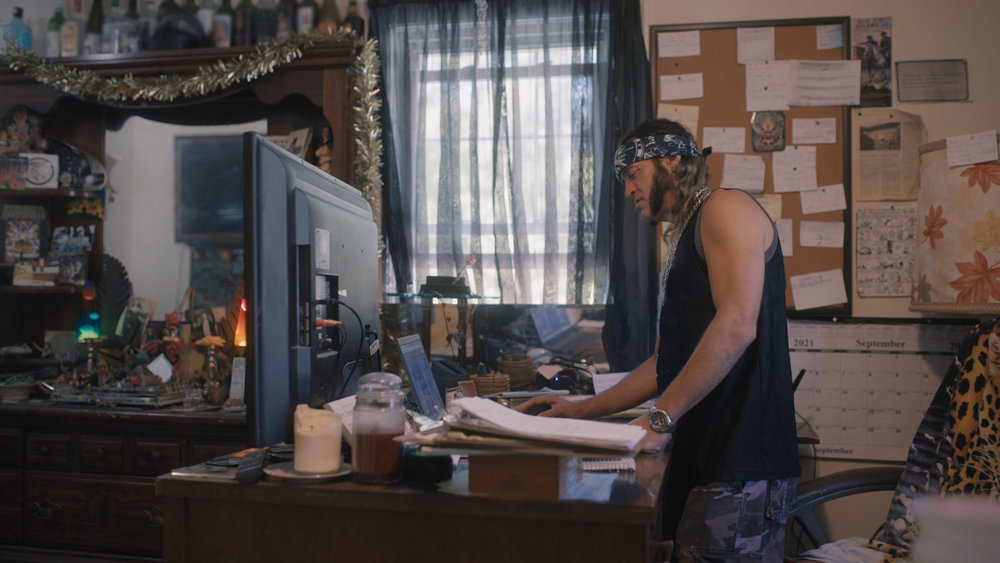‘Shadowland’ Could Be a Sequel to ‘The U.S. and the Holocaust’
A psychiatric nurse practitioner repeatedly disrupts school board meetings because she believes mask mandates are facilitating child sex trafficking. A formerly stable husband and father stumbles down the QAnon rabbit hole, claims to experience mysterious visions, and ultimately grows so obsessed that his wife sees no choice but to leave him. A disabled veteran becomes convinced that Americans are being systematically “replaced” by immigrants and announces that he’s running for governor of Texas, on a secessionist platform. A restaurant owner, her business devastated by the pandemic, faces trial for her role in the January 6 insurrection. Cameras capture her in the Capitol Building, screaming “They all need to hang!”
These are some of the most disturbing anecdotes in Peacock’s Shadowland, an uneven but frequently insightful documentary on the conspiracy theories currently ravaging the American public. Across six episodes, executive producer Joe Berlinger (Conversations with a Killer, the Paradise Lost trilogy) assembles portraits of the true believers, profiteers, and innocent victims of a constellation of false, deeply destructive right-wing myths, including Q, anti-vax, the Great Replacement, and more. The series can be harrowing to watch. On a human scale, families are destroyed and communities riven. More chilling still is the prospect that, even after Jan. 6, the most cataclysmic fallout of the proliferation of conspiracy theories is yet to come.

Christopher Key in ‘Shadowland’
Peacock
For a sense of how bad things can get—in a society that rarely lives up to its own melting-pot rhetoric—look no further than Ken Burns’ latest PBS docuseries, The U.S. and the Holocaust. University of Maryland history professor Jeffrey Herf spells it out in Shadowland: “The most important and famous conspiracy theory of the 20th century was the Nazis’ argument that the Jews started World War II.” As Germany descended into poverty and factionalism after the First World War, Herf says, “it explained things. And the explanation went along with a face.” Hitler didn’t have to work hard to sell new versions of conspiracy theories that dated back millennia and would, tragically, survive the fall of his genocidal regime. Shadowland subjects’ bizarre fixations on Illuminati and lizard people have roots in antisemitic lore that predates the Nazis.
Some of those delusions even originated on American soil. Burns’ typically textbook-like but genuinely illuminating series revisits the familiar story of how the Third Reich’s exploitation of its own Big Lie led to the Holocaust. But its unique contribution is to trace the conspiracy theory’s connection to and power over the United States, where Henry Ford had published screeds against the international Jewish community that helped inspire Mein Kampf and a President as progressive as FDR, fearing a public backlash, repeatedly failed to offer asylum to European Jews fleeing Hitler.
One of the most upsetting things about The U.S. and the Holocaust is its well-supported argument that America’s muted response was not a result of ignorance about what was happening in Germany as much as it was an expression of widespread, homegrown bigotry too tenacious to be debunked. Throughout the series, Burns and his co-directors Lynn Novick and Sarah Botstein point out that American newspapers and wire services were reporting on the Nazis’ persecution of Jews for years before the U.S. entered the war—and that pollsters continued to find most Americans unsympathetic to their plight, or at least unwilling to give them sanctuary. Government officials all the way up to the White House even entertained the baseless and ridiculous notion that German Jewish refugees might become spies for the Führer.

Party meeting or rally. Sign in the back reads: “Kauft nicht bei Juden”- Don’t buy from Jews.
Heinrich Hoffmann—courtesy of National Archives and Records Administration
Watching Shadowland alongside Burns’ series, it’s hard to avoid the conclusion that the U.S. is amassing all the necessary ingredients for a combustion of world-historical proportions. Of course, America in 2022 is not Germany in the 1930s, for reasons as varied as population size, diversity, shifting geopolitical realities, and a century of technological advancements that have altered just about every aspect of life in the developed world. Jews are only one among many groups targeted by the paranoid and hateful. Still, as Ellen Cushing of The Atlantic (whose reporting is the basis of Shadowland) puts it: “Conspiracy thinking has a body count.” In the U.S. that looks like not just Jan. 6, but also decades’ worth of mass shootings and other hate crimes targeting Jews, Muslims, immigrants, people of color, the LGBTQ community, and other minorities. These beliefs also filter up into mainstream politics and policies (see: the rise of the “QAnon candidate”) in ways that cause material harm to perceived outsiders.
“The time to stop a genocide is before it happens,” says the prominent historian Deborah Lipstadt in The U.S. and the Holocaust. But when so many Americans are already willing to abandon their families, poison themselves with fake COVID cures, go to jail, even kill and die in the name of perverse conspiracy theories, how can we avert tragedy? It seems like it should help to understand what motivates their adherents. Shadowland—which too often skirts the ugly prejudices that so many individual conspiracy believers endorse—offers a wealth of strong, if not novel, explanations: anxiety, loneliness, narcissism, money troubles, trauma. Some of the series’ subjects are exploiting disinformation for fame and profit. But many, from a woman who lost her retirement savings when her employer’s stock crashed to a veteran injured in pursuit of nonexistent weapons of mass destruction, have good reason to resent the rich and powerful.

Robert Chapman in ‘Shadowland’
Peacock
Unfortunately, both documentaries also illustrate how limited not just facts but empathy can be as a tool in the fight against conspiracy theories. If a devoted wife or a concerned child can’t pull a loved one out of the depths of delusion, what chance does anyone else have? Meanwhile, when the government cracks down on or the mainstream media debunks or social media sites ban accounts for harmful, conspiracy-related practices like the sale of bleach solutions as a panacea, it only further convinces true believers that they’re being silenced by a New World Order that doesn’t want people to find out the dark secrets they know. Many of the people in Shadowland really do appear to inhabit a sort of informational Upside Down, where they’ve discerned the truth and it’s people who trust science, journalism, and other fact-based epistemologies who are irrational, hysterical victims of brainwashing and groupthink.
The series has no obligation to solve the problem it documents, obviously. Still, the thinness of the solutions Shadowland floats is worrying. In a series finale that tackles the all-important question of how conspiracy theories end, Herf, the UMD professor, notes that in the past they’ve been squashed by a unified, nonpartisan message from trusted authorities in all sectors of a community’s public life—politicians and clergy, right and left—that they are lies. But considering how many of the series’ characters already vociferously mistrust officials across the political spectrum, it seems likely that the U.S. has passed the point at which such an effort, which doesn’t seem to be forthcoming anyway, could work. What happens in America instead may not turn out to be as extreme as the events revisited in The U.S. and the Holocaust, but there’s no denying that it constitutes the more convincing account of how conspiracy theories end.
More Must-Read Stories From TIME


